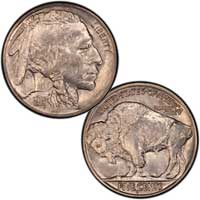1915-S nickels may be found quite well struck with the exception of LIBERTY. More common, however, are poorly struck pieces. The latter are sometimes semi proof like, as the weak strike failed to fully reshape the planchet and thereby changed its texture. Such brilliance may also result from over polishing the dies in an attempt to remove the all-too-common clash marks.
As with 1915-D, there seem to be quite a number of toned examples, with this toning rarely being attractive. Dull, monochromatic toning of brownish gold is typical.
The existence of numerous 1915-S nickels having extremely sharp strikes has led to speculation that proof dies were used to produce those coins. There are instances known in other coin series of retired proof dies being placed into general service, so this is not as far-fetched as it may seem. Of course, there’s really little difference between a proof die and a regular die that’s unworn, as both are capable of producing a sharp impression. It’s likely that at least one press run of 1915-S nickels enjoyed a fresh pair of dies set closely together. This would result in very well struck examples. It’s interesting to note that there are also many 1915-S Lincoln Cents having similarly sharp strikes.
Varieties:
- A triple-punched mintmark is one of the most distinctive such varieties in this series (FS-1915S-501).
- Another S/S/S variety is not quite as dramatic (FS-1915S-502).
- Minor obverse mechanical doubling, as well as clash marks on both obverse and reverse, are not unusual for this date. Neither phenomenon provides any additional value.
| Philadelphia | Denver | San Francisco |
| 20,986,220 | 7,569,000 | 1,505,000 |

